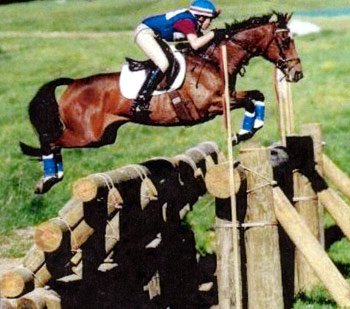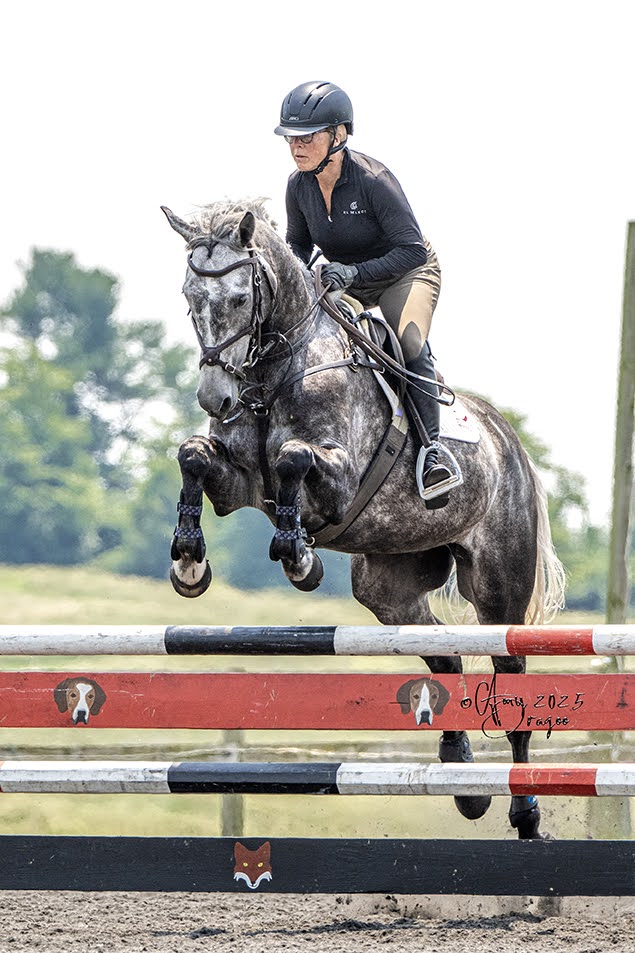We’ve been following along with four-star eventer Hilda Donahue, who’s originally from Ireland but now bases her business in Orlando, Fla., in her journey to complete the Virginia City 100 endurance ride in Nevada. Click here to read Hilda’s first blog. Did Hilda and Patrick complete the 100-mile endurance ride? You’ll have to read to find out!
From Hilda:
The drive into Virginia City, Nev., for my first endurance ride — nothing less than a 100-mile ride — was certainly a foreshadowing of what was to come. The town was built literally on the side of a mountain with elevations of 7,500 feet. As we traveled toward base camp — the equivalent to our stabling area — I kept looking for grassy trails. No such thing. We were in high desert land with mountains primarily comprised of quartz rock. Lucky me — I was about to experience this historic area on Patrick’s Fire, a beautiful Arabian gelding loaned to me by my sister-in-law.
Ride day began at 3:30 a.m. I awoke to howling, 30-mph winds and a weather report that was less than favorable for any outdoor activity. Like any motivated event competitor, not riding was not an option. Besides, having grown up in Ireland, I was well accustomed to challenging weather. Little did I know or anticipate that snow flurries awaited us!
By 4:30 a.m., I was ready to mount. Patrick was clearly ready. The moment I got in the tack, he gave an entertaining display of enthusiasm; it was an acrobatic performance including leaps, levades, caprioles and bucks on the asphalt in the dark. The thought of falling off before I ever got to the start line was beyond comprehension. How would I ever explain not even making it to the start? Patrick attracted considerable attention; I can assure you that I was now fully awake and ready to ride.
Forty-nine horse and rider combinations, most of which were Arabians, started the race. The youngest rider was 13 years old; the oldest was 71 years old. The previous day’s activities included the pre-ride vet check and a rider meeting, both similar to what we experience at CICs and CCIs. The vet check was extremely thorough, with every rider given a detailed chart that also must be shown at the many subsequent checks.
Things like capillary refill time, jugular refill, mucous membranes and the horse’s attitude are all monitored before, during and after the race. Acceptable pulse and respiration rates are determined according to weather and terrain. Horses have to reach the required pulse and respiration at each stop to be allowed to continue.
There is no stabling at these rides. Horses either stay tied overnight to their trailer — a high-tie system also appeared to be safe and popular — or small pens were erected. If horses were in pens, bedding was not put down. It is very different from our manner of setting up an elaborate stabling area with deep bedding and horses in stable bandages and magnetic blankets. These Arabians are tough, and simple, good old-fashioned horse care is practiced.
After about a mile hack to the start, all riders gathered outside the Delta Saloon. It reminded me of hunt meets back in my native Ireland, except it was pitch dark with no pack of hounds and no master to lead the way. The possibly of getting lost was my greatest fear. One hundred miles over foreign terrain following a trail marked with flour and ribbons tied to shrubs just did not give me much comfort.
Those of you who know me are well aware how directionally-challenged I am in daylight with GPS. Thank goodness that I did, in a sense, have a “master” — my sister in law, Sharon — to ride with. Sharon and her family are all familiar with the Virginia City trail. Ten miles into the ride, Patrick settled down nicely. His walk was relaxed and his trot more efficient. Cantering was kept to a minimum, but when we did he felt fantastic.
As dawn broke, I could not help but be moved by the beauty of the scenario. How fortunate was I — enjoying a wonderful horse, riding with experienced Sharon in historic, picturesque Virginia City? My biggest problem was that I had lost my hairnet, and my spare one was hard to access while navigating and riding in the dark. I was the only person riding with a hair net, lipstick and polished boots; I felt a bit odd!
At 18 miles, there was a trot-by where the vets observed soundness. Patrick felt and looked great. Sadly, Sharon’s older mare was mildly uneven behind. When we reached the first 45-minute vet check at 24 miles, Sharon sensibly withdrew her mare. In true good sportsmanship style , Sharon never complained and got to work advising me on how to continue successfully with Patrick.
I, of course, was horrified at the thought of losing my ” master.” While the McKenzie, Dutcher and Finston family team — these guys are pros at this— attended to Patrick’s needs during the 45-minute break, I pulled myself together, chanting, “You catch rode and completed at Adelaide on a horse called Kelycin FIASCO, so you can easily do this!”
Off I went, ALONE, into the unknown; thankfully, it was daylight, and after a few miles, I caught up with the delightful Lou Smith Egstrom. She lives in the Virginia City area and is an accomplished dressage and endurance rider. How perfect was that? Luck of the Irish, St.Patrick and/or my prayers with my husband that morning paid off.
By now, Patrick and I had become quite the team. He had established an impressive trot rhythm, covering the ground with maximum ease and efficiency. He told me when he needed walk breaks, and I was selective where I cantered. I guided him around the many rocks we encountered.
We climbed and descended 7,800 feet with grueling terrain. I was thankful to have the superbly comfortable Voltaire saddle to sit on, which allowed Patrick to use his back comfortably, along with his ThinLine pad. Patrick sure-footedly navigated his way up and down while I did my best to stay out of his way.
Rather amusing along the way was our experience with a herd of wild Mustangs who tried to follow us. I know I am desperate to have another event horse, but this was not my idea of how to acquire one. Not so amusing was the drastic weather changes; we encountered everything from high winds to snow flurries.
At the 36-mile, 15-minute vet check, Patrick was in 11th out of 12 horses and looking good. Each vet check stop was bustling with activity. Patrick’s crew got to work immediately, watering and feeding him, massaging his muscles, tending to his legs, and removing and checking tack. I stood back feeling helpless, but felt comfort in observing their experience. Thank you Sharon, Bob, Karon, Scott, Dustin, Ken, Jeff and Carolyn. I was feeling very sound myself, thanks to the comfortable and stylish Symphony breeches provided by Tredstep Ireland. If you have not tried them, I highly recommend the Symphony #3 Rosa breeches.
After the successful vet check, we trucked along and headed to the section of the ride referred to as the SOB due to the horrifically steep descent and climb, which you encounter three times in a row. Patrick cleverly navigated his way up and down; I did my best to stay out of his way. Once again, the luxury of the comfortable Voltaire saddle, the ThinLine pad and Tredstep breeches helped me tremendously.
The next stop was at 51 miles back at base camp in Virginia City. I was met by the dream team, and after the mandatory one-hour hold, we set off again into the wilderness. Our goal now was to deal with the predicted very high winds and freezing temperatures while getting to the 75-mile vet check before dark. This check was back again at base camp in Virginia City after a big loop back around the mountains.
Despite strong winds and snow flurries, (Saint) Patrick soldiered on. By 5:30 p.m. (12 and a half hours into the ride), the 75-mile stop was in sight. My instructions were to dismount about a quarter- mile away, loosen the girth and calmly lead Patrick in so he arrived with a low heart rate — looking good and, hopefully, relaxed. Shortly after I dismounted — right as Sharon approached to throw a cooler over him — Patrick spooked badly.
The wind had picked up even more, causing a piece of tin metal to dislodge from a roof, which created a horse-eating, terrifying noise. Patrick was close to being unmanageable for a few moments, and in his swift “flight” instinct, he stepped on his coronary band. We were literally 300 meters from the vet check. Patrick’s team iced his mild but sensitive injury, but despite all efforts, he jogged unsound.
Like all event riders know, the decision to not continue is never easy but always the correct one. Although I only got to ride 75 miles, I was thrilled with the fact that Patrick had taken me over that distance in wretched weather and terrain like I had never encountered. The next morning, Patrick sure looked great — what a relief! With great interest, I watched the vets assess what horse was worthy of the Best Conditioned Award.
The top-10 finishers are presented and jogged, turned sharply, halted and trotted on. They are also flexed and examined thoroughly, their attitude is assessed. I am proud to share that my husband, Ken, is a former recipient of the coveted Best Conditioned Award. The awards ceremony and breakfast was an enjoyable gathering. These endurance riders, not unlike most of us eventers, are a hardworking, helpful group who love their horses and seem to genuinely care about each other and their sport.
With great interest, I learned that the winning horses (this was a historic tie!) completed in 13 hours. The slowest horse completed in 20 hours and 13 mins — a great accomplishment, as the American Endurance Riders Conference motto states “to finish is to win.” I did not finish; I did not win. However, I had the most incredible riding experience, met some wonderful people and was reminded how awesome the McKenzie family is as they teamed together to ensure the horses well being.
Not unlike eventing, where there is a team behind the scenes that is key to any rider’s success, those “crewing” at these rides are invaluable. I could not have ridden the 75 miles without them. I have to also give credit to Andrea Cannon back in Florida for managing things at Ashmore while I was off in the mountains in Nevada.
Without a doubt, I want to thank some of my sponsors, Tredstep Ireland, Voltaire Design and ThinLine for helping myself and Patrick ride in comfort and style. After the busy winter/spring season here with students eventing, I am told that in March I will be starting back again with Patrick. Onwards!













































